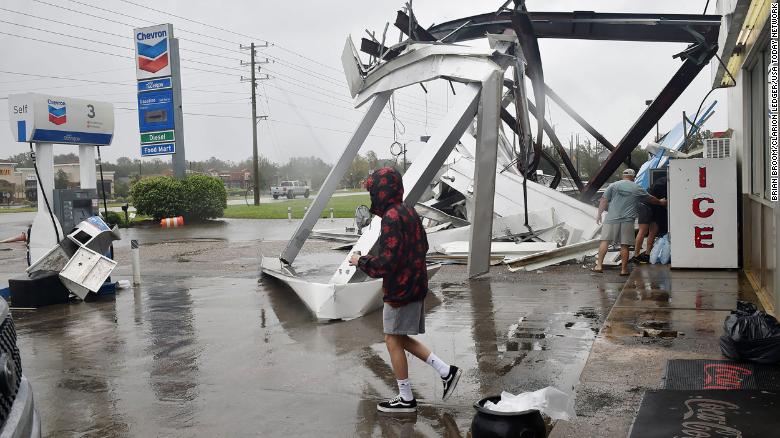(CNN) — Hundreds of people near the Florida-Alabama border were rescued from the flooding caused by Hurricane Sally on Wednesday. Authorities fear that many more may be in danger in the coming days.
“We had 30 inches of rain in Pensacola – more than 30 inches of rain – which is four months of rain in four hours,” Ginny Cranor, head of the Pensacola Fire Department, told CNN’s Wolf Blitzer on Wednesday.
Hurricane Sally has weakened since making landfall as a Category 2 hurricane on Wednesday morning. But its devastating number of damages was visible in the southern states at dusk.
By Wednesday night it was a tropical depression, according to the National Hurricane Center. By then it was about 15 miles northwest of Troy, Alabama, and had maximum sustained winds of 35 mph (56 km / h) and moving northeast at 14 km / h.
While all alerts and warnings have been suspended, Sally continues to bring torrential rains over eastern Alabama and western Georgia.
Hurricane Sally produced “historic and catastrophic” floods
Pensacola and other parts of Florida and Alabama were submerged by the flooding. Additionally, rivers were approaching dangerous levels and many counties were under curfews to keep residents safe.
“We are still on a lifesaving assessment and recovery mission, and we need to be able to do that job,” said Robert Bender, commissioner in Escambia County, Florida.
Sally unleashed up to 30 inches of rain from northwest Florida to Mobile Bay, Alabama. This caused “historic and catastrophic floods” at the site. The hurricane threatened more communities as it moved north, according to the National Hurricane Center.
In Escambia County, which includes Pensacola, at least 377 people have been rescued from flooded neighborhoods, Jason Rogers, the county’s director of public safety, told reporters at a news conference.
“It looks like a war zone”
“Guys … it’s going to be a long time to get out of this,” Escambia County Sheriff David Morgan said early Wednesday, warning that there could be thousands of evacuations.
Doris Stiers left her beach home in Gulf Shores, Alabama, to assess Sally’s damage on Wednesday and found her community had changed.
“It looks like a war zone,” Doris Stiers told CNN. ‘Much destruction, houses destroyed, roofs missing. I have not had any service, electricity or internet. Bad night”.
The path Sally will follow
Sally made landfall as a Category 2 hurricane near Gulf Shores, Alabama, around 4:45 am local time, with sustained winds of 168 km / h.
Thus, the slow pace of the storm, now around 7 mph, was unleashing a damaging deluge in Alabama and the Florida Panhandle on Wednesday night. Additionally, some areas have already accumulated more than 24 inches of rain and could receive as much as 90 inches by the end of the storm.
Hurricane Sally is forecast to continue moving northeast through Alabama Wednesday night. Also, the center of the storm is expected to move to Georgia and South Carolina on Thursday.
A section of Pensacola’s Three Mile Bridge is missing
A section of the newly constructed Pensacola Bay Bridge, connecting the city of Gulf Breeze, is missing due to the storm, authorities said.
A barge crashed into a portion of the structure, known to locals as the Three Mile Bridge, on Tuesday causing the damage, Brad Baker, Santa Rosa County’s director of public safety, said in a Facebook video Wednesday.
Photo from the Three Mile Bridge showing the missing section. pic.twitter.com/Ym3VRBhml5
— Santa Rosa County Emergency Management (@SRC_EM) September 16, 2020
“Anyone who uses the Three Mile Bridge should know that it will be a while before they can use it again,” said Baker.
Baker said crews are working to catch the barge that caused damage before it hits something else.
Flood emergencies and half a million people without electricity
Floods have turned streets into rivers in Pensacola. At least eight rivers in southwest Alabama and the western Florida Panhandle are expected to reach major flood stages Wednesday night, tweeted the National Weather Service office in Mobile.
The meteorological service had declared a flash flood emergency for “serious threat to human life and catastrophic damage from a flash flood.” The warning zone covers parts of the Alabama coast and the Florida Panhandle, including Gulf Shores and Pensacola.

The flooding was severe in Navarre Beach, Florida, at Sally’s expense.
–
Up to 90 centimeters of rain
More than 500,000 people are without power in Alabama and Florida, according to PowerOutage.us.
Total rainfall of 10 to 90 centimeters is possible from Mobile Bay to Tallahassee, Florida, forecasters say.
Sally made landfall 16 years after the day a Category 3 Hurricane Ivan struck roughly the same areas.
Sally is expected to turn north and then northeast, bringing with it strong winds and more potential for flooding.
Central Alabama and Central Georgia could eventually see 4 to 12 inches of rain, with possible significant flash flooding. Parts of the Carolinas could receive 4 to 23 centimeters of rain later in the week.
Mandatory evacuations were ordered for much of the coastline and low-lying areas from Mississippi to Florida. Shelters were also opened to accommodate evacuees.
Much damage by Sally
Florida Governor Ron DeSantis said “virtually any body of water in Northwest Florida” could see levels rise in the coming days due to Sally.
“There will be a lot of property damage,” DeSantis said at a news conference Wednesday. “When you look at downtown Pensacola, you see a meter of water there, that will probably affect every business in downtown Pensacola, there just aren’t two ways to do it.”
Floods in Alabama
In Alabama, the floor and walls of the 16th floor of a hotel on the north edge of Mobile Bay creaked as Sally reached the shore.
The building shook as if it were in the middle of a prolonged low-grade earthquake, and the sturdy windows appeared ready to open, a CNN team said there.
In Orange Beach, Alabama, water flowed at least a foot deep along the outer walls of tourist tents. Here’s a video taken from a boat moving through the Cajun Marina before sunrise.
On the shore, a boat sat on its side not far from an overturned refrigerator, according to images posted on Facebook.
Daylight revealed that another loose boat had landed against an Orange Beach condo building, a photo of resident Rich Florczyk showed. The flooded streets were littered with fallen tree branches and other debris.
Fallen trees and lots of rain
Meanwhile, on Dauphin Island, south of Mobile, “we have downed trees everywhere … (and) the power was cut across the island,” Mayor Jeff Collier said Wednesday morning.


People stock up on ice and other items at a damaged store near Spanish Fort, Alabama.
–
As the wind and rain beat down even before midnight, huge trees had already been felled west of Mobile.
Workers in raincoats supported Sally’s bands as they worked alongside a bulldozer to move thick piles of branches on Campfire and Ponderosa roads, CNN affiliate WALA reported.
Similar scenes unfolded around the same time, still about six hours before Sally made landfall, in downtown Mobile and across Mobile Bay in Fairhope, Alabama.
Sally is the fourth hurricane to make landfall in the United States this year, the most at this point in a year since 2004. It is also the eighth named storm to make landfall in the United States, the most on record as of March 16. September.
– CNN’s Michelle Krupa, Hollie SIlverman, Gary Tuchman, Ed Lavandera, Gabe Ramirez, David Williams, Brandon Miller and Alisha Ebrahimji contributed to this report.
–


